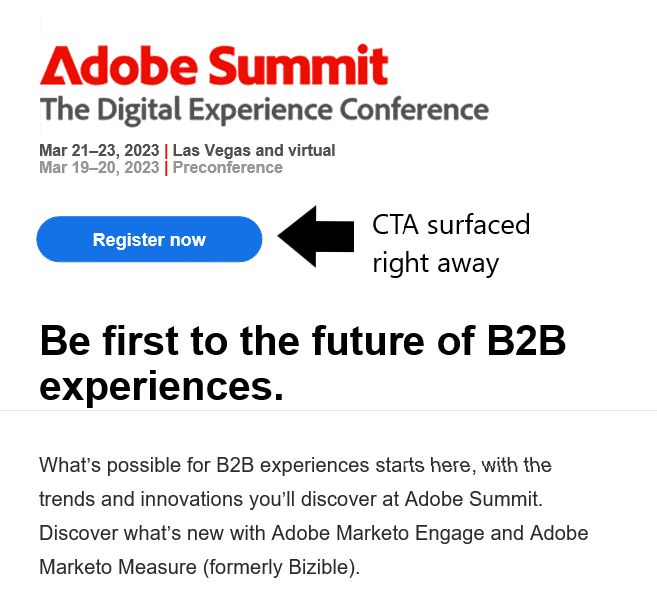Click-Through Rate (CTR): What does it mean?
Click through rate (CTR) is one of the quintessential measures of determining a marketing campaign’s success.
It measures the number of clicks an ad or link receives per the number of impressions.
Impressions are the number of times your content (whether an ad or a link) is displayed, no matter if it was clicked or not.
Want to learn how to optimize your click-through rate across all channels? Read on to learn more.
To calculate CTR, you will divide the number of clicks from the impressions for the link or ad you’re trying to track. For example, if you had 100 clicks and 1,000 impressions, then your CTR would be 10%.
Achieving a high CTR is paramount to your campaign performance, because it shows if your target audience finds your content engaging and relevant to their needs.
Additionally, if you’re running a paid campaign, you pay every time someone clicks your ad.
If you have a low CTR or if people are clicking through but not performing the desired action once they get to your landing page, this signals a larger issue with the quality of your on-page content.
What's a good click-through rate?
As with any marketing initiative, it’s crucial to have a firm understanding of how to effectively measure success.
Knowing what a good CTR is can help you establish benchmarks, define clear goals, and assess overall performance.
However, there is often confusion about what constitutes a good CTR.
This is largely dependent on the type of campaign you’re running, the keywords you’re targeting, the channel, and your end goal.

Of course, your end goal is to have a high CTR, but the actual number you’ll want to target is dependent on a number of factors.
In addition to the type of campaign you’re running, average CTR will also vary by industry. For example, the average search network CTR for the education industry is 5.46%.
If your business falls in the education industry, you’d want to target a CTR a little higher than the average, so your stretch goal might be closer to a 6-7% CTR.
For travel and hospitality, the average search advertising CTR is 8.54% – so businesses that fall in that segment would want to work towards a CTR of 9-10%.
You can find more common CTR rates by industry to help you set benchmarks for success in the graphic below: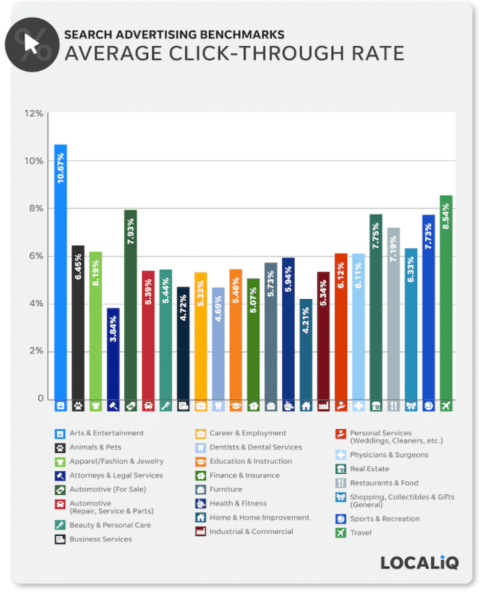
Screenshot from LOCALiQ.com, January 2023
The average click-through rate across all industries was 3.17% in 2021. According to LOCALiQ’s CTR data collected in 2022, the industries they studied and combined outperformed that CTR, averaging over 6%.
As you can see, this data is always evolving so it’s important to consistently monitor and analyze industry standards to set accurate and relevant goals.
Is a higher click-through rate the best measure of success?
It may seem counterintuitive, but a high CTR isn’t always beneficial for your business.
Ideally, you’d want to have the highest CTR possible as well as your end-users taking desired action once they click-through to your landing page.
If your end users are landing on your site and then clicking away, you’re wasting your resources.
Learn how and where it’s beneficial to have a high CTR and when it may not be the best measure of success by reading more.
In some instances, such as PPC and other ad campaigns, you’re paying for every click. The more clicks, the more money you’re spending.
If your visitors aren’t finding value in the content you present after they click-through and they leave without taking action, your ad spend is pointless.
Even if you don’t have money tied to CTR, such as an email campaign, it’s still important to analyze how consumers are engaging with your content post-click.
While CTR is an important marketing metric to track and measure, there are numerous other metrics you need to consider too to get the full picture. A few additional metrics you’ll want to track include:
Website performance metrics
- Total visits: How many visitors a web property receives. This could include a single web page or your entire website
- Unique visits: Counts a single visitor. For example, if someone visits your website on three different occasions, it will only count as one unique visit.
- Returning visits: Counts the number of times a user comes back to your website after their initial visit. This helps show you how valuable your website visitors find your content to be.
- Pageviews: The total number of views a particular page receives.
- Session duration: How long a visitor spends on your site during a single browsing session. This metric helps you see how useful users find your content to be; the longer a visitor spends on your site, the more value they’re getting with your content.
- Bounce rate: The percentage of visitors that leave a web page without taking an action. This means they leave without clicking any links, filling out a form, or navigating to a different web page. The higher your bounce rate is for a web page, the less value your readers are finding. A high bounce rate presents an opportunity to optimize that page’s content.
Each of the above metrics hold significant importance when measuring campaign performance. Don’t neglect to look at these metrics too when assessing successes and opportunities for improvement.
These metrics are most closely tied to CTR, but there are an abundance of additional marketing metrics to consider for different channels.
The metrics you’ll track and analyze to determine your campaign’s performance will look different for each of your channels.
How to improve your CTR
Now that you have an understanding of the definition of CTR, how to determine what a good CTR rate is, and additional marketing metrics you’ll want to measure, you likely also want to know how to improve your CTR.
In this section, we’ll discuss strategies for optimizing CTR across multiple channels and best practices for each.
Improving click-through rate for email
Your email marketing metrics will look much different than your SEO metrics.
For example, a few metrics you’d want to consider for email marketing, in addition to CTR, include the number of your email subscribers, open rate, email list growth rate, sharing or forwarding, and unsubscribe rate.
Your email click-through rate will also differ from your other marketing efforts on different channels. Email CTR varies by industry, so it’s important to determine what an average CTR looks like for your industry.
According to Mailchimp, the average CTR for beauty and personal care brands is 1.92%. Conversely, hobby brands see a higher average CTR at 5.01%.
Email CTR varies per industry when looking at this report, but the average CTR across all industries is 2.62%.
If your email marketing CTR falls beneath this threshold, this is an indication that you should actively be taking steps to improve it. To improve your email CTR, you’ll want to:
- Ensure your messaging is clear and concise. Customers want to read an email’s information at a glance, so consolidate your message as much as possible while still delivering value.
- Segment your email recipients. Customers crave personalization, so if you’re emailing your entire list the same content, you’re likely not tailoring your email content to their individual needs. Segmenting your list helps bucket customers based on interests and needs.
- Test your email performance. Use multiple headlines and test your CTA button’s placement within your copy. See what resonates best with your subscribers.
- Surface your CTA buttons higher in your email. Don’t wait until the end of your email to incorporate your CTA. Make it easy for readers to take action right away.
Improving click-through rate for SEO
First, let’s consider how to improve your CTR in search engine results. Please note, when we refer to “search engines”, we really only mean Google because Google generates over 92% of all global search traffic.
When considering CTR for search results, this will depend on your position on the first page because 75% of people don’t open second-page results.
The higher you are on the search engine results pages (SERPs), the more clicks you’ll get and the higher CTR you’ll see. To get to the top of the SERPs, you’ll need a comprehensive SEO strategy:
- Create high-quality, relevant content often (blog posts, customer testimonials, product pages, company page, and more)
- Update outdated pieces of content to be more relevant or redirecting older content to newer, more relevant content pieces
- Focus on link-building (both internal and external links)
- Optimize content for relevant keywords based on your keyword research
- Create content for every step of your customer journey and each of your buyer personas
- Optimize on-page SEO elements (such as your image file names, image and video sizes, meta descriptions, headers, and more)
- Improve your page loading time
- Claim, maintain, and optimize your Google Business Profile for local SEO
- Ensure your website is mobile-friendly to account for mobile-first indexing
Keep in mind SEO is a long-term marketing strategy that won’t deliver immediate results. Therefore, it may take a while to see your click-through ratio improve as well as your position in the SERPs.
For quicker fixes, consider taking advantage of the following:
Use brackets
According to Hubspot, using brackets in your title improves the CTR by 38%. Brackets divide your title and provide additional information about your context.
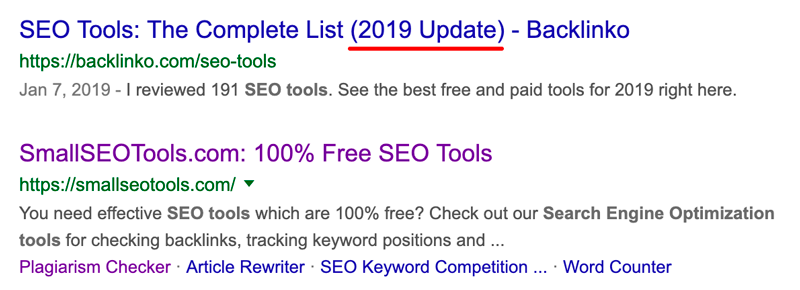
Use numbers
According to Moz, using numbers in your title improves CTR by 36%. People like numbers: 30% discount, fresh content for 2019, Top 10 blog posts of 2023, etc.
Strangely, users pay more attention to uneven numbers than to even numbers, e.g. 3, 7, 11, 142.
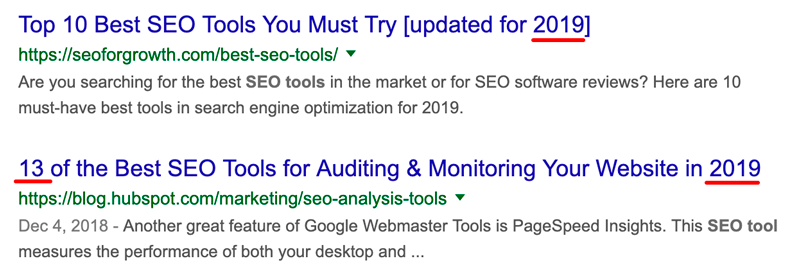
Capitalize Every Word in Your Title, except for articles and prepositions.
This is a simple rule, but unfortunately many websites ignore this one.
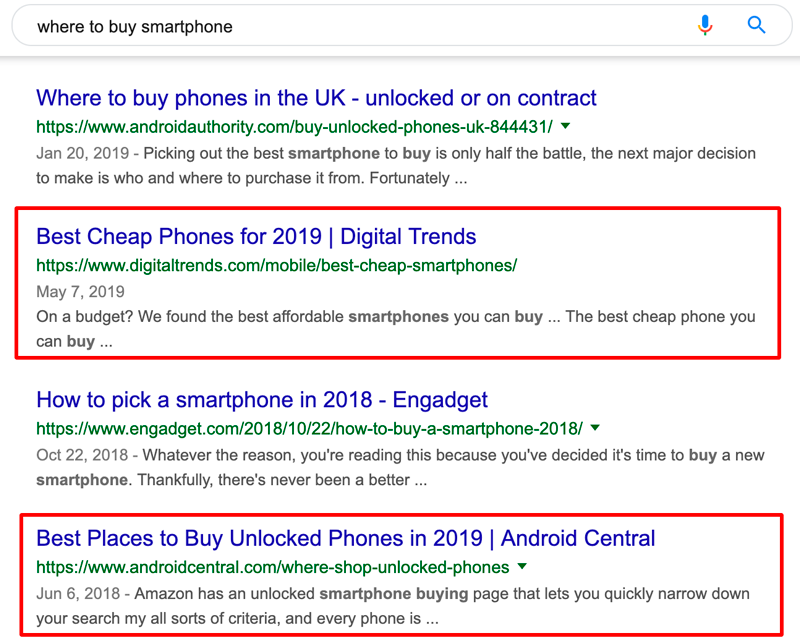
Use your domain or brand name at the end of your title if you have a strong brand.
On average, users scan titles by reading the first three words before deciding whether to read the whole title. If you insert your domain name in the beginning part of the title, it confuses your users, as well as Google.
If you insert your domain name in the beginning part of the title, it confuses your users, as well as Google. It’s much better to hook your user’s attention at the beginning of your title and use your brand or domain name at the end.
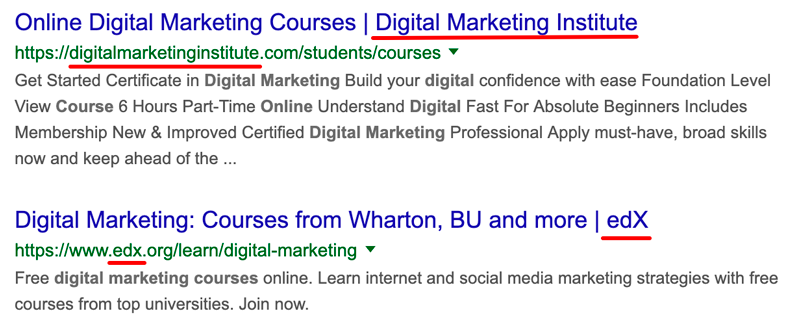

We recommend inserting your brand name only if your brand name is recognizable and could benefit from the exposure.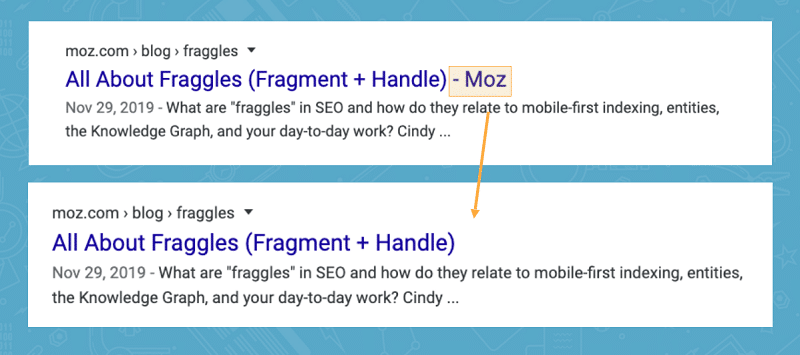
(Image courtesy of Moz)
For example, according to a test performed by Moz, when they removed their brand name from their title, the traffic for that page dropped 4%.
They found that popular brand names in titles almost always perform better than unknown brands, even when people aren’t searching for your brand specifically.
Increase curiosity
Remember that 75% of people make decisions by using their emotions. Your title is no exception. There are different types of emotions: surprise, joy, trust, fear, anger, anticipation, etc.
Provoke their curiosity. You may ask – how can I find emotional words to use in my title?
The best place is by looking at other people’s Google Ads to draw inspiration. Go to Google and insert your related keywords in order to find which emotional words are ranking.
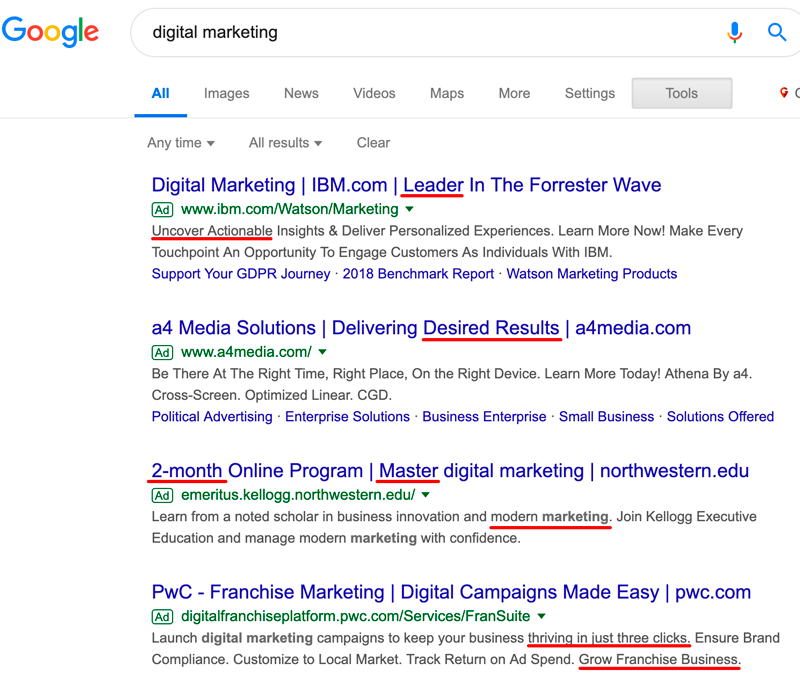
Consider what the optimal title length is.
Google counts a title’s length by using pixels. Each symbol has its own length, e.g. on the table below I have listed some common variants.
| Symbol | Length |
| a | 10 |
| A | 12 |
| i | 4 |
| I | 6 |
| w | 13 |
| W | 17 |
| , | 6 |
| / | 6 |
The maximum length of a title is 600 pixels, which equals 5-10 words or 50-70 symbols. According to Orbitmedia, the optimal length of a title is 55 symbols.
Therefore, you need to write a title that contains all the relevant information you want to convey without exceeding 55 symbols.
The reason for this is that Google cuts long titles, and short titles might not contain enough information to get your reader hooked.

You can control the length of your meta-information by using the popular Yoast WordPress plugin. While you are typing your title in the SEO title field, it will highlight this field with green or red lines.
If your title is in green, you’re in the allowed viewable limit. If your title is highlighted in red, you’ll want to make your title shorter.
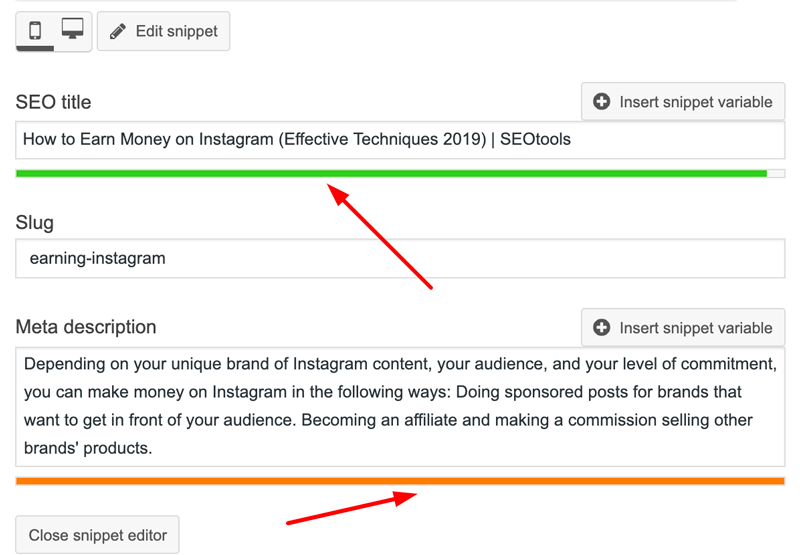
Write a compelling description
Your meta description explains your content, what your visitors will see on your website and it can help improve your CTR.
This description is a code on your page that is created specifically to give search engines a brief description of what your content entails.
<head>
<meta name=”description” content=”CTR is a marketing metric that estimates the ratio of clicks and impressions. The formula looks like CTR = clicks/impressions*100%”>
</head>
If you don’t enter a meta description, Google will automatically choose the text on your page that is more related to searched keywords.
However, it’s better to write a compelling description yourself rather than leaving this to Google. The average length of a description is 160 symbols, although search systems display longer descriptions as well.
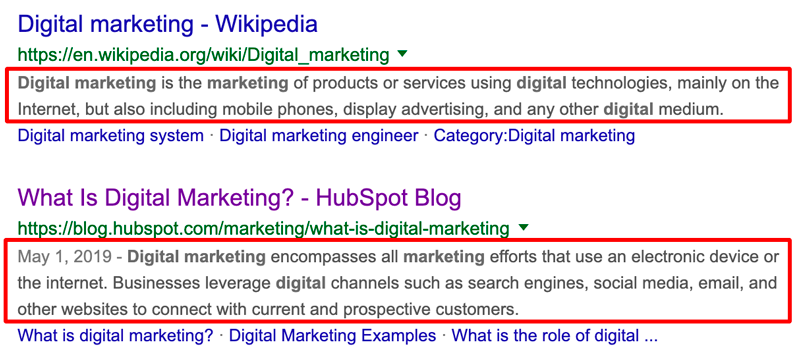
Google webmaster trends analyst Martin Splitt states that meta-information is the second most important ranking factor after content.
Use Structured Data
Search crawlers or bots scan your content differently than a human. You see the visual part of your content with your eyes.
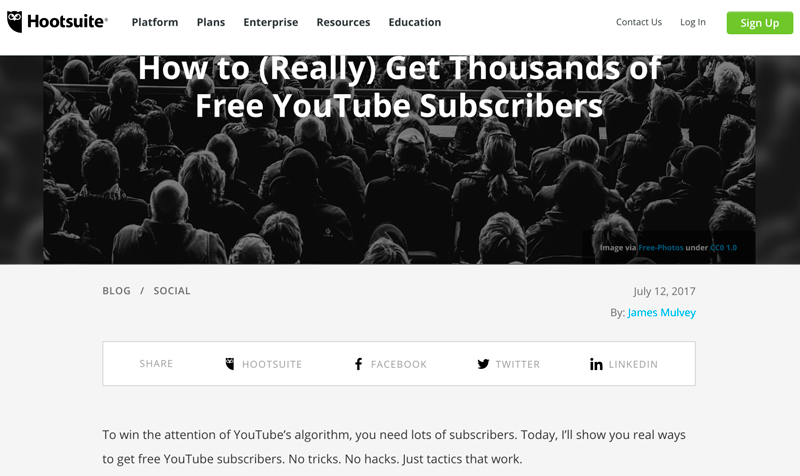
However, search bots scan the actual code of your content.
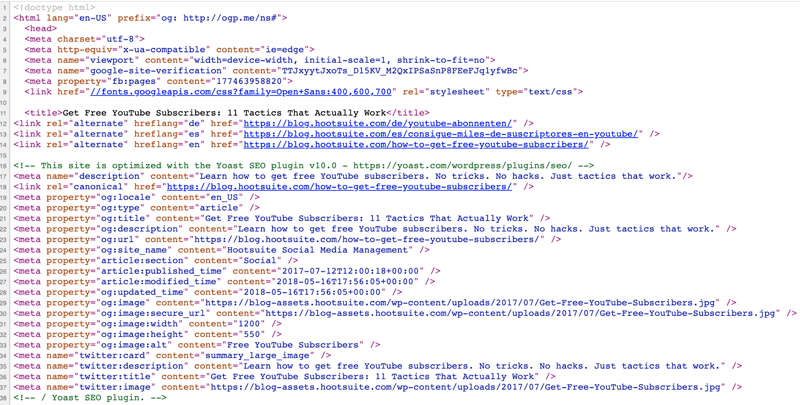
Thereafter, search systems rank your content on their search results.
Google doesn’t display only blue hyperlinks in your search; there are many other elements such as featured and rich snippets, knowledge boxes, videos, and image carousels to name a few.
Below, you can see what a featured snippet looks like on Google’s SERPs.
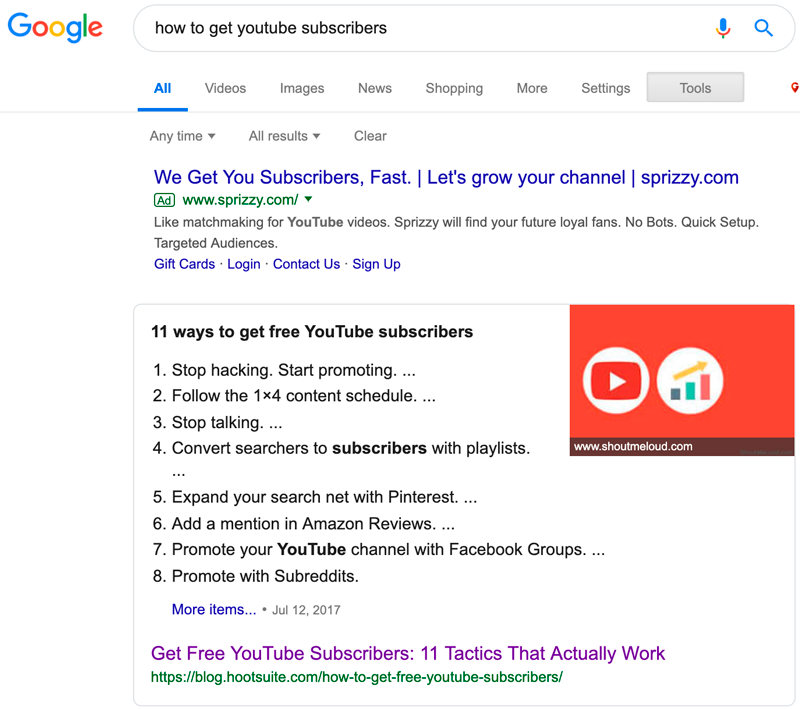
How does Google surface this type of information? The answer is structured data. Structured data was created in partnership with Google, Bing, Yahoo, and Yandex with the sole purpose of understanding and organizing online content.
Imagine you have a new video you’ve spent ample time creating. You want this to show up as a featured snippet in the SERPs so you add SeekToAction markup to your page to improve your chances.
According to Hubspot, structured data helps you to increase your CTR by 30%. These are a few formats of vocabulary-structured data:
- schema.org – the most popular and universal format supported by Google, Bing, Yahoo and Yandex
- dublincore.org
- xmlns.com
There are also grammar formats of structured data:
- json-ld.org – Google recommends this format, wherein other grammar formats of structured data are supported by Google, as well
- w3.org (Microdata)
- w3.org (RDFa)
When you or your web-developer set up structured data to your site – check the correct validation by using this useful Google tool. Google created another free useful tool that allows you to set up structured data manually.
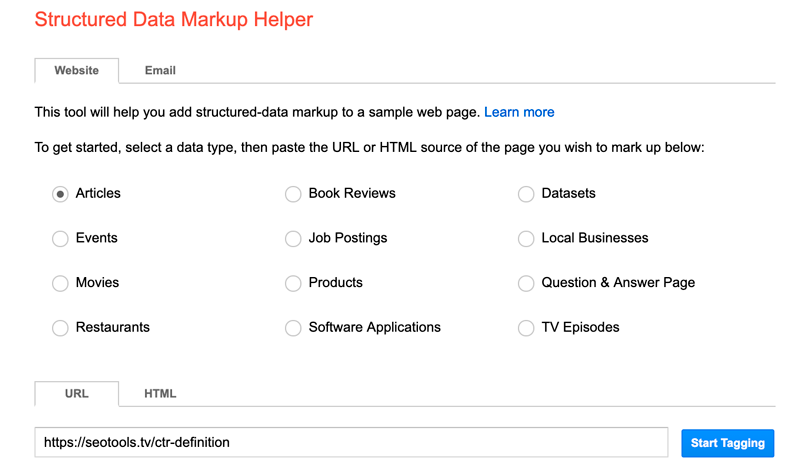
Read more information about using structured data by Google here.
Create descriptive URLs
According to Brian Dean, shorter URLs rank better than longer ones.
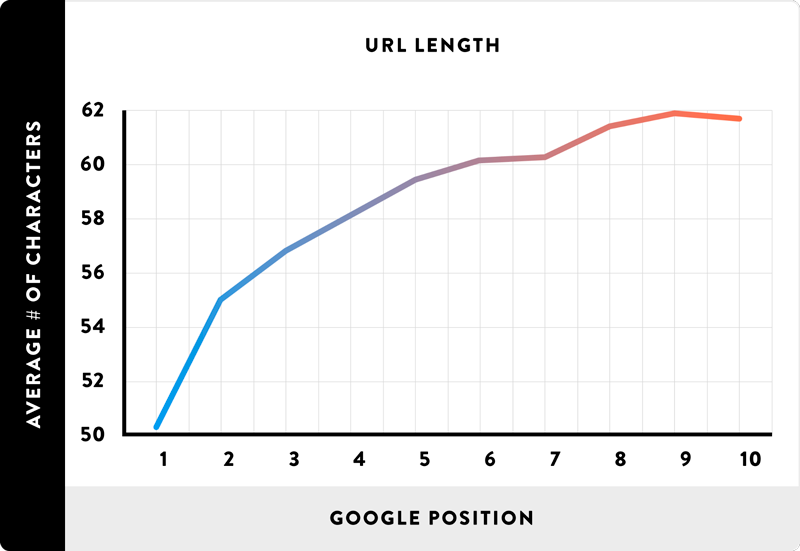
Use your main keyword and breadcrumbs (correct structure divided by slashes) when creating your URL in order to help users understand what type of content you have.
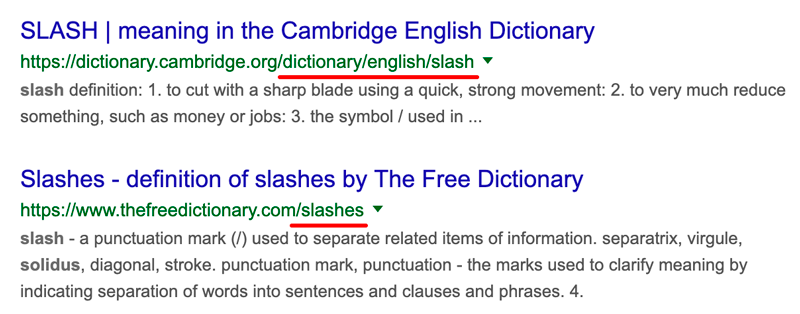
Use Google Analytics and Search Console to analyze your results
To analyze your CTR, you will want to use tools such Google Analytics and Google Console. These tools provide analytics data and other useful metrics for your website.
The average CTR for all pages of your website can be checked by Google Console on the “Performance” tab.
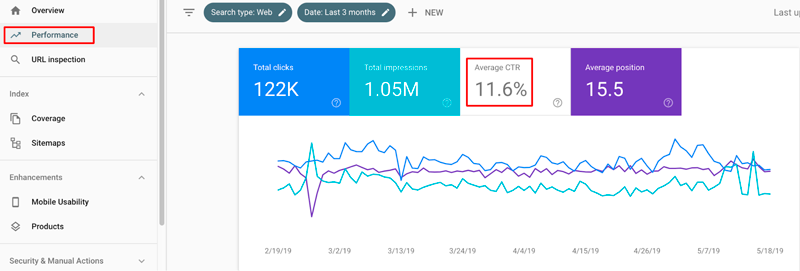
By scrolling down you will see the CTR for all searched keywords on your website.
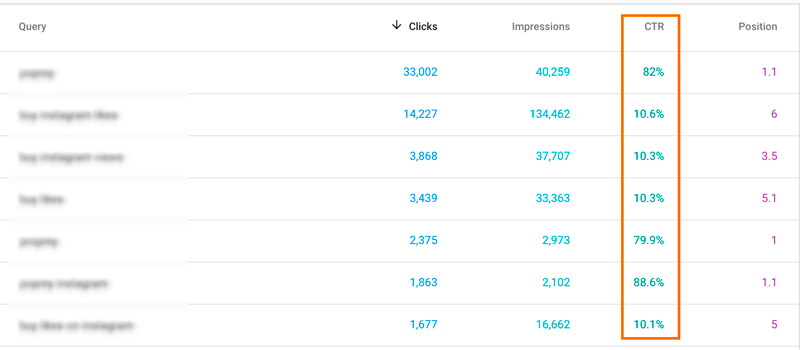
The same results can also be checked on Google analytics (Acquisition → Search Console → Queries).
Improving your click-through rate for PPC activities
PPC (Pay per click) is a paid advertising model that supports Google, Facebook, and other platforms in which the advertiser pays for clicks rather than impressions.
A low CTR in your Google Ads campaign increases your CPC (Cost per click). Don’t want to pay more?
Check out the following 7 techniques to increase your PPC CTR dramatically. According to Statista, Google’s advertising revenue is increasing at an alarming rate each year.
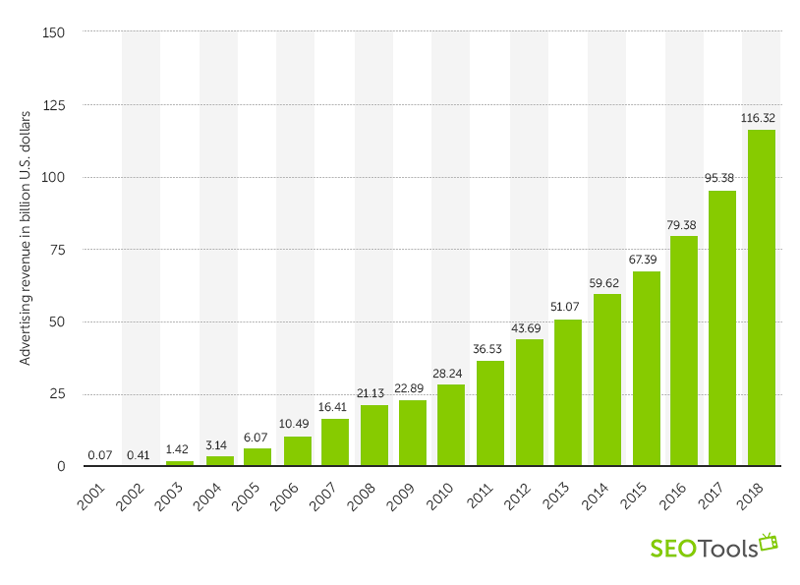
Do you think Google would want to stop earning more and more revenue? Of course not. They are extremely profitable as a result of their PPC advertising model.
Google calculates the quality score for PPC campaigns using these parameters: your competitors’ rates, other bids, ad extensions, and ad rankings. In order to improve your quality score, you need to improve the CTR in your ads.
In the graph above, it is clear that Google ads are extremely competitive. Without the knowledge and know-how of how to increase your CTR, you cannot earn enough to pay back your expenses.
Here are seven tried and true techniques we recommend.
- Use SEO techniques
Utilize the same on-page SEO techniques to improve the CTR for your paid ads:
- Insert brackets, numbers and other symbols anywhere in your headlines or other ad extensions to increase CTR by up to 74%.
- Capitalize every word in your headline, except prepositions.
- Increase curiosity.
- Write compelling and emotional ad copy.
- Test your ad copy to see what resonates best with your audience.
- Add a countdown timer to create urgency
According to Google’s Blog, Clarks Americas stated that by using a countdown timer over the Black Friday and Cyber Monday promotional periods, they increased their CTR by 32%.
Urgency creates and increases FOMO (the fear of missing out) that provokes customers to want to take action right away. You can easily set up a countdown feature in your Google Ads Campaign.
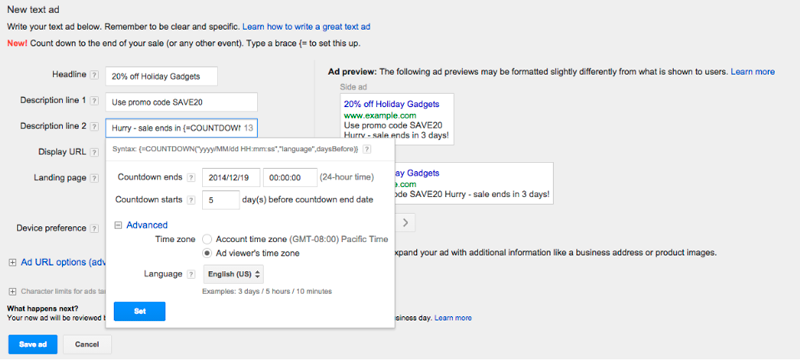
- Use ad extensions
Ad extensions increase your ad’s visibility in order to provide additional information about your product or service. Combine keywords with other related topics or supply extra information that customers often ask for.
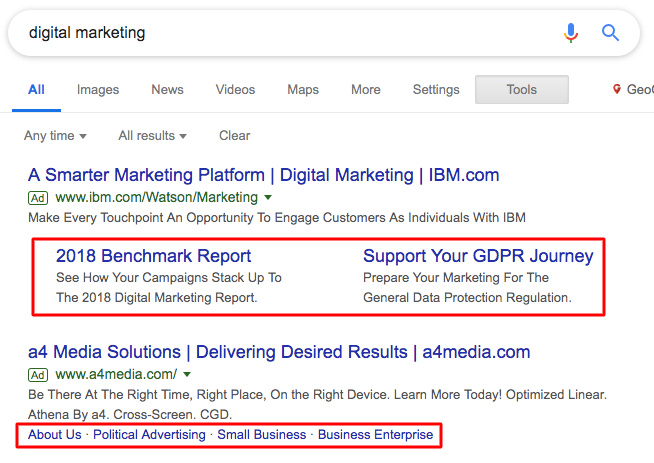
There are several formats of ad extensions that increase CTR by up to 53%:
- Ad sitelinks provide direct links to other related pages on your website by increasing CTR to 25%.
- Review extensions from reputable sources and rankings – reviews and awards increase the level of trust and CTR by 10%.
- Local extensions lead customers to your physical location because of their proximity and increase CTR by 10%.
- Call extensions increase CTR by 8%, so provide your phone number for customers who want to contact you.
- App extensions help customers directly open apps on their devices, leading to more downloads of your app.
- Use your main keyword in URLs’ ads
According to Wordstream, 33% of Google ads don’t use their main keywords in their URLs. Why use this simple technique?
The fact of the matter is that there are a lot of irrelevant ads which confuse customers on their buying journey. Nobody likes to waste time with irrelevant information.
The main keywords in URLs confirm that the content is relevant to the customers’ needs.
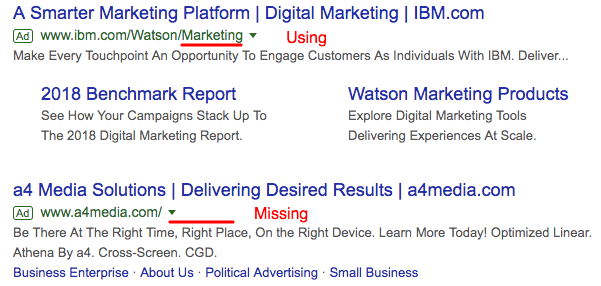
- Use a call to action
It’s not enough to just use compelling copy in your ads. You have to motivate consumers to move forward with your business by using phrases such as:
- buy now;
- find out more;
- get yours today;
- get full insurance;
- purchase;
- call today;
- order;
- browse;
- sign up;
- get a quote;
- download the e-book.
Consumers need to be told what to do and your call to action should clearly state that customers can buy goods or services on your website.
- Avoid broad match keywords
Avoid using broad match keywords in your marketing campaigns, because these keywords are irrelevant to your main audience. When users are forced to view irrelevant ads, they simply ignore them – significantly decreasing your CTR.
A low CTR decreases your quality indicators, which in turn supplies Google with a reason to increase the CPC for your ads.
Use other types of keywords such as modified broad, phrases, and exact matches in order to establish contact with your target audience.
| Type of keyword | Combination for Google Ads | Examples of users’ intent |
| Broad match | social media marketing | digital marketing certificate |
| Broad match modifier | +social +media +marketing | social marketing in public health and other media |
| Phrase match | “social media marketing” | social media marketing proposal |
| Exact match | [social media marketing] | social media marketing |
| Negative match | add keywords that are irrelevant to your proposal: job, salary, cheap, free |
- Use trial and error
You don’t know exactly what type of text will work for your ads, but by trial and error, you can get to know what works and what doesn’t work. Before starting paid ads, you need to take three important steps:
- Get to know your target audience.
- Analyze your competitors and find their weak spots.
- Conduct numerous tests to see what works.
Getting to know your target audience is the most important factor. If you don’t know who your customers are, how can you expect to effectively sell to them?
Start the learning process by analyzing your existing customers and assume scenarios by replying to these questions:
- What problems do they have?
- What pain do they experience?
- How can you be of assistance?
Your sales department needs to communicate with your customers in order to transfer this information over to your marketing department.
If starting from scratch, then research and find relevant data on the internet. There are many case studies which contain a lot of useful data regarding different niches.
What also helps is to create your ideal customer persona: age, sex, job, interests, etc.
Only once you have completed this job, do more tests to get to know your customers. Set up some possible variants in your marketing campaign and choose the variant that works best for you.
It doesn’t just stop here, because you should also be selling on social media – and if you’re not, then I suggest you learn how to. Fast.
Conclusion
CTR is an important marketing metric to continuously monitor across all applicable marketing channels and campaigns. In most instances, you’ll want a higher CTR, especially when it comes to endeavors such as email, social media, and SEO.
The higher your CTR is on these platforms, the more likely you are to increase your sales. Leverage the aforementioned techniques to improve your CTR.
Remember each channel will have different barometers for success and each needs to have its own strategy. Look towards industry averages for different channels to solidify your CTR goals.
If you have additional questions, feel free to ask me in the comments below. Also, check out these articles for more information:




